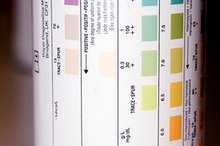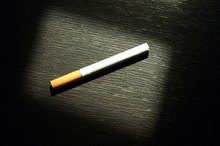Reasons for False Positives for Nicotine on a Blood Test
A blood test can be used to check for nicotine. The reasons for this can vary, but nicotine is an indication that a person smokes, which can have a large impact on a person’s health. Urine or saliva testing could also be used to test for nicotine. While some tests indicate levels of nicotine present in the bloodstream, other tests indicate either a positive or negative. There are several reasons why a blood test for nicotine can yield a false positive.
Diet
The consumption of some foods before the blood test can elevate levels of substances that can cause false positives for nicotine. These foods include broccoli, cabbage, mustard, garlic, radishes, almonds and horseradish. Vegetarians can have elevated levels of a substance called thiocyanate, which can be a source of a false positive on a blood test for nicotine.
Environmental Exposure
Can Blood Tests Detect Nicotine?
Learn More
People who have particular work environments can have elevated levels of thiocyanate, which can cause a false positive. The work environment is related to working with metal. The related occupations include electroplaters and people who refine precious metals.
Nicotine Products
Nicotine patches, nicotine gum and other nicotine products that are used in smoking cessation programs will yield positives on nicotine blood tests. These are not false positives, because nicotine is actually present in the bloodstream, but unless the testing facility is advised that the nicotine product is being used, there can be a false indication of smoking.
Lab Error
Physical Effects of Nicotine on the Heart Rate
Learn More
As with any human endeavor, there can be errors as a result of human error. Laboratory samples can be mislabeled. Results can be misinterpreted. Good labs have systems in place to minimize these human errors, but they can occur.
- As with any human endeavor, there can be errors as a result of human error.
- Laboratory samples can be mislabeled.
Related Articles
References
- The American Academy of Insurance Medicine: A Comparison of Carboxyhemoglobin, Thiocyanate and Cotinine as Screening Tests
- Cancer Epidemiology, Biomarkers & Prevention: Validation of Self-Reported Smoking Status Using Saliva Cotinine -- A Rapid Semiquantitative Dipstick Method
- American Lung Association. State legislated actions on tobacco issues (SLATI). Updated March 3, 2020.
- U.S. Food & Drug Administration. Selling tobacco products in retail stores. Updated December 20, 2019.
- Valentine G, Sofuoglu M. Cognitive effects of nicotine: Recent progress. Curr Neuropharmacol. 2018;16(4):403-414. doi:10.2174/1570159X15666171103152136
- Kim S. Overview of cotinine cutoff values for smoking status classification. Int J Environ Res Public Health. 2016;13(12):1236. doi:10.3390/ijerph13121236
- Dhavan P, Bassi S, Stigler MH, et al. Using salivary cotinine to validate self-reports of tobacco use by Indian youth living in low-income neighborhoods. Asian Pac J Cancer Prev. 2011;12(10):2551-4.
- Vélez de Mendizábal N, Jones DR, Jahn A, Bies RR, Brown JW. Nicotine and cotinine exposure from electronic cigarettes: A population approach. Clin Pharmacokinet. 2015;54(6):615-626. doi:10.1007/s40262-014-0221-7
- American Cancer Society. Why people start smoking and why it’s hard to stop. Updated November 13, 2015.
- American Lung Association. What it means to be "nic-sick". Updated October 2, 2019.
- American Association of Poison Control Centers. E-cigarettes and liquid nicotine. Updated May 31, 2020.
- McLaughlin I, Dani JA, De Biasi M. Nicotine withdrawal. Curr Top Behav Neurosci. 2015;24:99-123. doi:10.1007/978-3-319-13482-6_4
Writer Bio
Doug Hewitt has been writing for over 20 years and has a Master of Arts from University of North Carolina-Greensboro. He authored the book "The Practical Guide to Weekend Parenting," which includes health and fitness hints for parents. He and his wife, Robin, are coauthors of the "Free College Resource Book."







